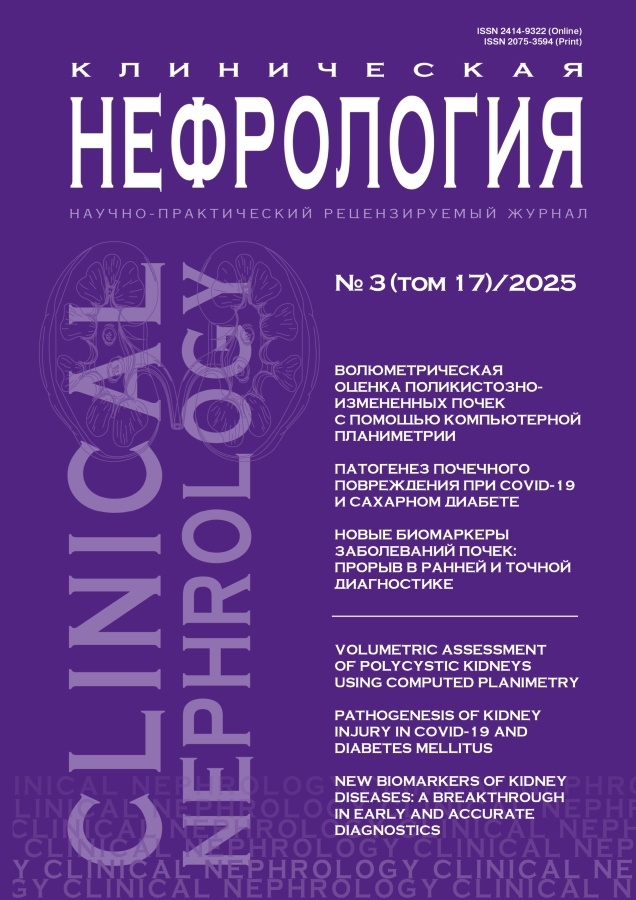New biomarkers of kidney diseases: a breakthrough in early and accurate diagnostics
- Авторлар: Aitbaev K.A.1, Murkamilov I.T.1,2, Fomin V.V.3, Murkamilova Z.A.4, Raimzhanov Z.R.5, Yusupov F.A.6, Yusupov A.F.6, Yusupova T.F.6, Yusupova Z.F.6, Baitelieva A.K.2
-
Мекемелер:
- Salymbekov University
- I.K. Akhunbaev Kyrgyz state medical academy
- Russian Medical Academy of Continuous Professional Education
- Family Medicine Center №7
- N.N. Burdenko Main Military Clinical Hospital
- Osh State University
- Шығарылым: Том 17, № 3 (2025)
- Беттер: 85-89
- Бөлім: Лекция
- URL: https://journals.eco-vector.com/2075-3594/article/view/692788
- DOI: https://doi.org/10.18565/nephrology.2025.3.85-89
- ID: 692788
Дәйексөз келтіру
Аннотация
Kidney diseases pose a significant threat to public health worldwide, with early detection, timely intervention, and accurate monitoring being critical to prevent progression to end-stage kidney disease and improve patient outcomes. However, traditional markers of kidney disease, such as serum creatinine, blood urea nitrogen, and estimated glomerular filtration rate, have limitations in sensitivity and specificity in detecting early renal dysfunction. In recent years, rapid advances in molecular biology, proteomics, and metabolomics have led to the discovery of a number of new biomarkers that are gradually finding application in clinical practice. This mini-review discusses some of the emerging biomarkers of kidney disease, including cystatin C (Cys-C), neutrophil gelatinase-associated lipocalin (NGAL), and kidney injury molecule-1 (KIM-1), which have become valuable tools for the early detection of renal failure, paving the way for improved clinical management and quality of patient care. Despite the enormous potential of these markers, issues such as standardization, cost-effectiveness, and large-scale validation still need to be addressed before they can be widely used. Future research should be aimed at optimizing detection methods, establishing clinical decision thresholds, and assessing the value of these markers in personalized medicine, thereby paving new avenues for accurate diagnosis and treatment of kidney diseases.
Негізгі сөздер
Толық мәтін
Авторлар туралы
Kubanych Aitbaev
Salymbekov University
Хат алмасуға жауапты Автор.
Email: aitbaev.kuban1940@gmail.com
ORCID iD: 0000-0003-4973-039X
Dr.Sci. (Med.), Professor, Consultant of the Resuscitation, Therapy and Diagnostics Department of the Multidisciplinary Medical Center
Қырғызстан, BishkekIlkhom Murkamilov
Salymbekov University; I.K. Akhunbaev Kyrgyz state medical academy
Email: murkamilov.i@mail.ru
ORCID iD: 0000-0001-8513-9279
Dr.Sci. (Med.), Corresponding Member of the Russian Academy of Natural Sciences, Associate Professor, Department of Faculty Therapy, Director of the Multidisciplinary Medical Center «Doc University Clinic»
Қырғызстан, Bishkek; BishkekViktor Fomin
Russian Medical Academy of Continuous Professional Education
Email: fomin_vic@mail.ru
ORCID iD: 0000-0002-2682-4417
Dr.Sci. (Med.), Professor, Academician of the Russian Academy of Sciences, Rector
Ресей, MoscowZhamila Murkamilova
Family Medicine Center №7
Email: murkamilovazh.t@mail.ru
ORCID iD: 0000-0002-7653-0433
therapist
Қырғызстан, BishkekZafarbek Raimzhanov
N.N. Burdenko Main Military Clinical Hospital
Email: rzrmam@mail.ru
ORCID iD: 0000-0001-5746-6731
Neurologist, 29th Neurological Department
Ресей, MoscowFurkat Yusupov
Osh State University
Email: furcat_y@mail.ru
ORCID iD: 0000-0003-0632-6653
Dr.Sci. (Med.), Professor, Head of the Department of Neurology, Neurosurgery and Psychiatry, Medical Faculty
Қырғызстан, OshAbdulkhokim Yusupov
Osh State University
Email: furcat_y@mail.ru
ORCID iD: 0000-0002-6449-8229
Teaching Assistant, Department of Neurology, Neurosurgery and Psychiatry, Medical Faculty
Қырғызстан, OshTursunoy Yusupova
Osh State University
Email: yusupova_tursunoy_f@mail.ru
ORCID iD: 0000-0002-8502-2203
Clinical Resident at the Department of Neurology, Neurosurgery and Psychiatry, Medical Faculty
Қырғызстан, OshZulhumor Yusupova
Osh State University
Email: yusupova_tursunoy_f@mail.ru
ORCID iD: 0000-0001-7621-1128
5th-year student of the Faculty of Medicine
Қырғызстан, OshAltynay Baitelieva
I.K. Akhunbaev Kyrgyz state medical academy
Email: altynaibaitelieva.k@gmail.com
ORCID iD: 0000-0001-6668-9451
Cand.Sci. (Med.), Head of the Department of Scientific, Innovative and Clinical Work
Қырғызстан, BishkekӘдебиет тізімі
- Rayego-Mateos S., Valdivielso J.M. New therapeutic targets in chronic kidney disease progression and renal fibrosis. Expert Opin. Ther. Targets. 2020;24(7):655–70. doi: 10.1080/14728222.2020.1762173.
- Mallamaci F., Pisano A., Tripepi G. Physical activity in chronic kidney disease and the EXerCise Introduction To Enhance trial. Nephrol. Dial. Transplant. 2020;35(Suppl. 2):ii18–22. doi: 10.1093/ndt/gfaa012.
- Carrero J.J., González-Ortiz A., Avesani C.M. et al. Plant-based diets to manage the risks and complications of chronic kidney disease. Nat. Rev. Nephrol. 2020;16(9):525–42. doi: 10.1038/s41581-020-0297-2.
- Lv J., Li M.M. Research progress of urinary exosome microRNAs in kidney diseases [J]. Chin. J. Pathophysiol. 2020;36(02):378–84. doi: 10.54097/eerw7s17.
- Wang Q.S. Study on the diagnostic value of urine microalbumin/creatinine ratio, serum creatinine and serum cystatin C for early renal damage in elderly hypertensive patients [D]. Soochow University. 2017.
- Li T., Wu Y., Yuan S.T. et al. Research progress of urinary peptide biomarkers in chronic kidney disease [J]. Hebei Med. 2024;30(05):877–80.
- Liang X.J. Diagnostic value of cystatin C for kidney injury [J]. Int. J. Lab. Med. 2016;37(23):3365–7.
- Ashani L., Esakky I.E., Solomon R. et al. Potential for Novel Biomarkers in Diabetes-Associated Chronic Kidney Disease: Epigenome, Metabolome, and Gut Microbiome [J]. Biomedicines..2020;8(9).
- Gill K.L.S., Amatullah N., Tran T. et al. Contemporary considerations for nephrotoxin stewardship: Estimating kidney function and use of novel biomarkers [J]. J. Am. College Clin. Pharm.2024;7(8).
- Li XY. The significance of urinary NGAL and KIM-1 in acute kidney injury before and after high-dose methotrexate treatment in children with acute lymphoblastic leukemia [D]. Zhengzhou University 2017.
- Wang D, Li J, Wang Y. Study on the relationship between serum creatinine, urea nitrogen and cystatin C levels and the severity of nephrotic syndrome [J]. Clin. Res. 2024;32(05):139–42.
- Guo H., Li Z.H., Wang S.J. et al. Research progress of new biomarkers for nephrotic syndrome [J]. Hainan Med. J. 2018;29(10):1430–3.
- Rizvi M.S., Kashani K.B. Biomarkers for Early Detection of Acute Kidney Injury. J. Appl. Lab. Med. 2017;2(3):386–99. doi: 10.1373/jalm.2017.023325.
- Zhang R.F., Ma J.G., Liu X.X. The test of KIM-1, Cys C and β2-MG to assess the early renal damage in OSAHS patients and its clinical significance. J. Clin. Otorhinolaryngol. Head Neck Surg. 2017;31(3):174–9. doi: 10.13201/j.issn.1001-1781.2017.03.003.
- Zang Q. Study on the relationship between urinary liver-type fatty acid binding protein and inflammatory response in chronic kidney disease progression [D]. Hebei Med. Univer. 2016.
- Tanabe J., Ogura Y., Kosaki K. et al. Relationship between Urinary Liver‐Type Fatty Acid‐Binding Protein (L‐FABP) and Sarcopenia in Spontaneously Diabetic Torii Fatty Rats. J. Diab. Res. 2020;1:7614035.
- Parikh C.R., Devarajan P., Zappitelli M. et al. TRIBE-AKI Consortium. Postoperative biomarkers predict acute kidney injury and poor outcomes after pediatric cardiac surgery. J. Am. Soc. Nephrol. 2011;22(9):1737–47. doi: 10.1681/ASN.2010111163.
Қосымша файлдар







